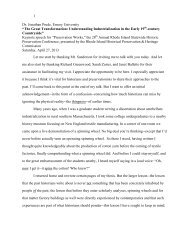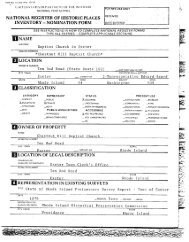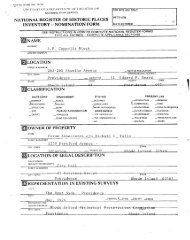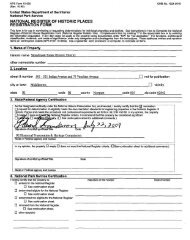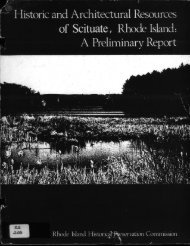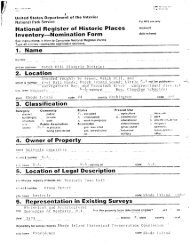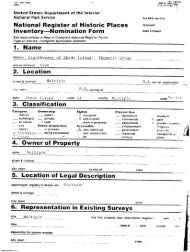National Park Service - Rhode Island Historical Preservation ...
National Park Service - Rhode Island Historical Preservation ...
National Park Service - Rhode Island Historical Preservation ...
Create successful ePaper yourself
Turn your PDF publications into a flip-book with our unique Google optimized e-Paper software.
0MB PC 1024-0018<br />
NPS Form 10300-a Exp. 0-31-84<br />
3-82<br />
United States Department of the Interior<br />
<strong>National</strong> <strong>Park</strong> <strong>Service</strong><br />
<strong>National</strong> Register of Historic’ Places<br />
Inventory-Nomination Form<br />
Continuation sheet 3 Item number 7<br />
Page 4<br />
housing--that on Amos Stteet multi-unit, that on Brown Street<br />
single-family. Kimball Street is a short, dead-end right-of-way<br />
off Brown Street on which stand three good early twentiethcentury<br />
bungalows. Turn-of-the-century Branch Street, connecting<br />
Church Street and School Street, is characterized by a variety of<br />
modest late nineteenth-and twentieth-century dwellings. By<br />
contrast, Indian Run Road just to the east, bordered by a small<br />
brookside park between it and Kingstown Road, has a row of<br />
closely related company-built Colonial Revival dwellings<br />
possessing considerable architectural interest. School Street, a<br />
late nineteenth-century roadway at the south end of the <strong>National</strong><br />
Register historic district, has wakefield-oriented commercial and<br />
residential properties on its south side. The north side, within<br />
the district boundary, includes properties facing Indian Run Road<br />
and Branch Street, as well as the former High School now the<br />
School Street Apartments, #157 and Hazard School #115.<br />
The above account should not mislead the reader into<br />
thinking that Peace Dale lacks coherence. On the contrary, and<br />
issues of boundary definition notwithstanding, Peace Dale<br />
possesses remarkable unity, which can be defined in terms of<br />
purpose, focus, ownership, period, design, authorship, and<br />
ambience. Peace Dale is a mill village. Nearly all the<br />
buildings in the village were built for operations of the Peace<br />
Dale Manufacturing Company, to house its owners and workers, or<br />
to serve these same people when not at work. Peace Dale in every<br />
sense focuses on the mills, and on the adjacent facilities for<br />
commerce, recreation, education, relaxation, and worship provided<br />
by mills’ owners, the Hazard family. There are some 180<br />
properties in the Peace Dale historic district inventory;<br />
discounting roughly 20 non-historic buildings, there remain 160<br />
historically significant properties. Of these, about 110 are<br />
directly associated with the Peace Dale Manufacturing Company and<br />
the Hazard family. Moreover, every noteworthy building erected<br />
in every period up to the Second World war is associated with the<br />
Hazards--from "The Cottage" #17, of c.1790, the oldest building<br />
in Peace’ Dale, purchased by Rowland Hazard I in 1804 and used and<br />
reworked by generations of family into the 1960s; to the first<br />
stone mill of 1847 #37B; the second stone mill and office<br />
building of 1856 #37E and 40; the Congregational Church and<br />
railroad station of the ‘70s #106 and 82; The Acorns’ 1882,<br />
#71; the Hazard Memorial of 1891-92 #38; the turn-of-the<br />
century Colonial Revival dwelling built by the Company #149,<br />
#151, #154, and 164-167; the Neighborhood Guild of 1907-08<br />
#94; Hazard School 1911, #115; Stepping Stone Kindergarten<br />
1916-17, #124; and the Peace Dale School of 1923 #1.







